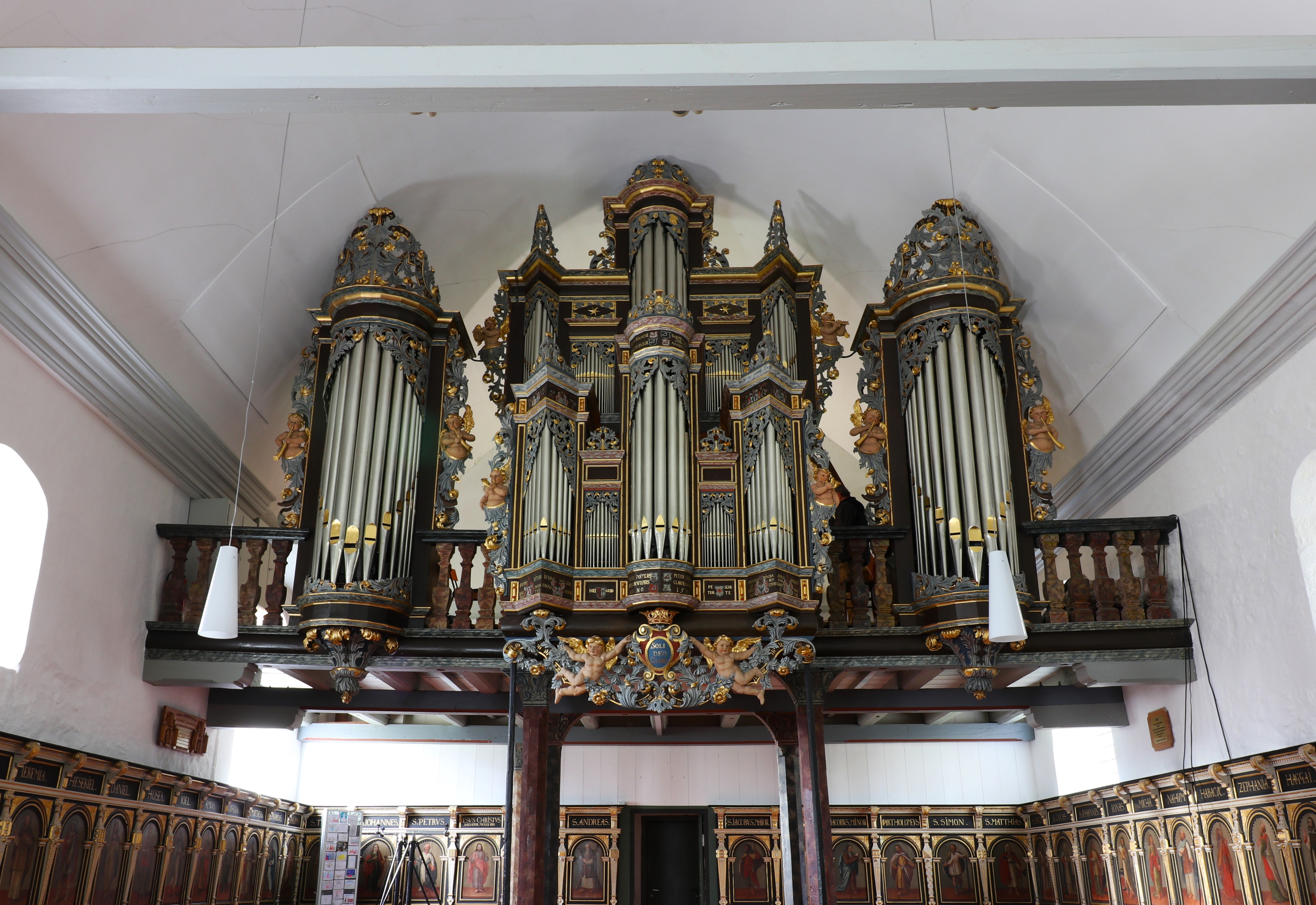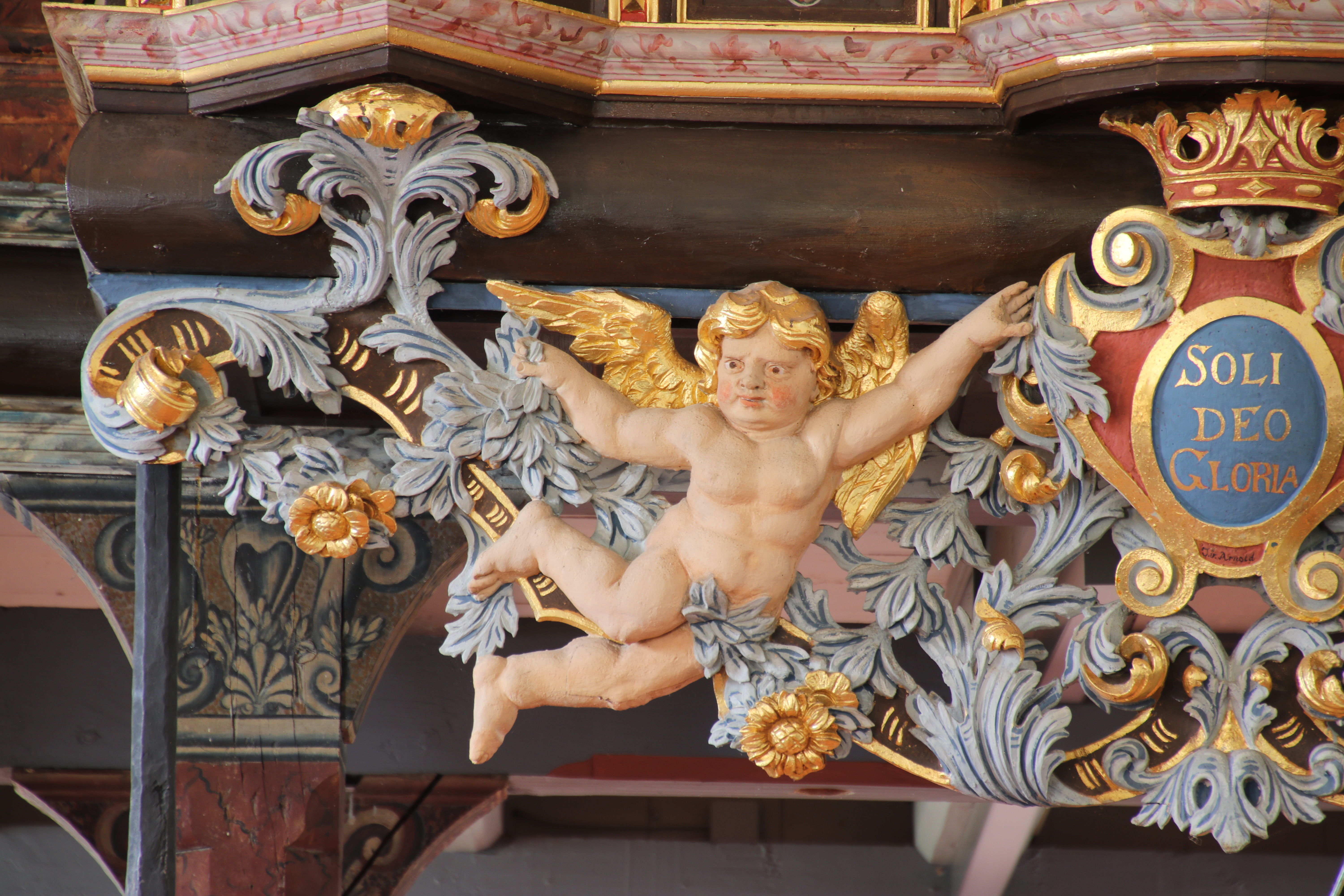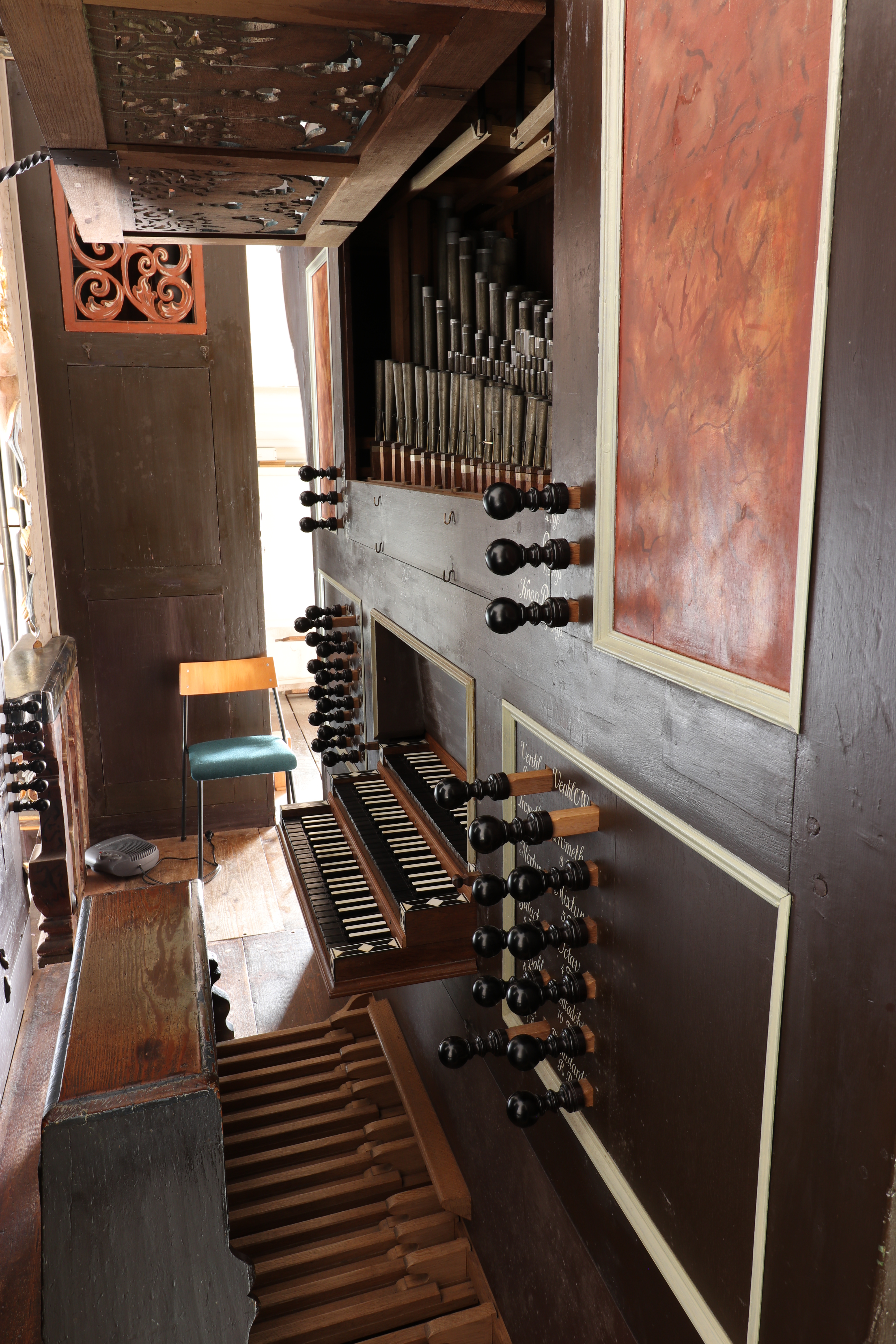Altenbruch, St. Nicolai
| Builder | J. H. Klapmeyer |
|---|---|
| Year | ca. 1730 |
| Period/Style | Baroque |
| Stops | 35 |
| Keyboards | 3+P |
| Keyaction | tracker/mechanical |
| Tuning | Werckmeister III at 478 Hz |
| Sampleset |
Available
 , sampled by
Sonus Paradisi
, sampled by
Sonus Paradisi
|
The St. Nikolai church in Altenbruch owns one of the oldest North German organs. In 1497-1498, Johannes Coci built a small organ of 6 stops. It stood near the main altar. Matthias Mahn enlarged the instrument in 1577 (or 1561?) by adding a Rückpositiv.Today, some of the Coci organ's pipes are still incorporated into the RP Gedact 8', OW Quintadohn 16', and Pedal Untersatz 16'. Other pre-1647 pipe material is to be found in the RP Principahl 8', Octav 4', Nasat 3', and Blockfloit 2'.
In 1647, Hans Christoph Fritzsche renewed the organ, enlarging the Hauptwerk as well. The Principal plenum of the Hauptwerk (called also the Oberwerk) is formed from his pipes today. His pipes also sound in the Quintadöhn 8', Gedact 4', Sexquialtera, and Mixtur of the Rückpositiv. Matthias Dropa expanded the compass of the instrument in 1698 and provided additional stops, especially in Pedal. His pipes still sound today in the RP Kromhorn 8', Octav 2', Pedal Gedact 8', Octav 4', Mixtur, Posaun 16', and Trometh 8'. A few decades later, the church was rebuilt and a west choir was added. Consequently, Johann Hinrich Klapmeyer (1690-1757) was commissioned to relocate the organ into a newly constructed west gallery. The organ was substantially reworked as well between 1727-1730. The organ builder added new Pedal towers and supplied the Pedal Principal 8'. He also inserted a new Brustwerk of 6 stops under the chest of the Oberwerk, and he added new reed stops to the Oberwerk:Trometh 8' and Vox humana 8'. Klapmeyer provided the organ with its present look. The organ survived until the present mostly unchanged. It was restored in 2004 by the Ahrend organ workshop.
The organ consists of three manuals and a pedal: altogether 2100 pipes and 35 sounding stops. The presence of 3 independent Principal 8 stops (in Oberwerk, Rückpositiv, and Pedal) is one remarkable feature of this instrument. It is a stylistically pure instrument and emblematic of the North German organ building school. The so called Hadeln liturgy adopted in 1567 anticipated the use of the organ as a solo instrument, thus contributing to the elevated art of the organ building and organ use in the Altenbruch church. The organ is especially suitable for early North German music, such as the work of H. Scheidemann, M. Weckmann, F. Tunder, and D. Buxtehude.
In 1647, Hans Christoph Fritzsche renewed the organ, enlarging the Hauptwerk as well. The Principal plenum of the Hauptwerk (called also the Oberwerk) is formed from his pipes today. His pipes also sound in the Quintadöhn 8', Gedact 4', Sexquialtera, and Mixtur of the Rückpositiv. Matthias Dropa expanded the compass of the instrument in 1698 and provided additional stops, especially in Pedal. His pipes still sound today in the RP Kromhorn 8', Octav 2', Pedal Gedact 8', Octav 4', Mixtur, Posaun 16', and Trometh 8'. A few decades later, the church was rebuilt and a west choir was added. Consequently, Johann Hinrich Klapmeyer (1690-1757) was commissioned to relocate the organ into a newly constructed west gallery. The organ was substantially reworked as well between 1727-1730. The organ builder added new Pedal towers and supplied the Pedal Principal 8'. He also inserted a new Brustwerk of 6 stops under the chest of the Oberwerk, and he added new reed stops to the Oberwerk:Trometh 8' and Vox humana 8'. Klapmeyer provided the organ with its present look. The organ survived until the present mostly unchanged. It was restored in 2004 by the Ahrend organ workshop.
The organ consists of three manuals and a pedal: altogether 2100 pipes and 35 sounding stops. The presence of 3 independent Principal 8 stops (in Oberwerk, Rückpositiv, and Pedal) is one remarkable feature of this instrument. It is a stylistically pure instrument and emblematic of the North German organ building school. The so called Hadeln liturgy adopted in 1567 anticipated the use of the organ as a solo instrument, thus contributing to the elevated art of the organ building and organ use in the Altenbruch church. The organ is especially suitable for early North German music, such as the work of H. Scheidemann, M. Weckmann, F. Tunder, and D. Buxtehude.
| Rückpositiv | Oberwerk | Brustwerk | Pedal |
|---|---|---|---|
| Principahl 8′ | Quintadöhn 16′ | Gedact 8′ | Untersatz 16′ |
| Gedact 8′ | Principahl 8′ | Gedact 4′ | Prinzipahl 8′ |
| Quintadöhn 8′ | Gedact 8′ | Octav 2′ | Gedact 8′ |
| Octav 4′ | Octav 4′ | Quint 11/2′ | Octav 4′ |
| Gedact 4′ | Waldfloit 2′ | Scharff III | Mixtur IV |
| Nasat 3′ | Mixtur V | Knop Regal 8′ | Posaun 16′ |
| Octav 2′ | Cimbel III | Trometh 8′ | |
| Blockfloit 2′ | Trometh 8′ | Corneth 2′ | |
| Sexquialtera II | Vox humana 8′ | ||
| Mixtur IV | |||
| Dulcian 16′ | |||
| Kromhorn 8′ |
1512668621-Praeludium in E dur Vincent L beck
0:00
0:00
1513030084-BuxWV139
0:00
0:00
1511228454-Anonymous Nuremburg Tab Intrada AltenbruchSurr
0:00
0:00
1512136886-BWV 767
0:00
0:00
https://www.sonusparadisi.cz/en/organs/germany/klapmeyer-organ-altenbruch.html
 Pipe Organ Map
Pipe Organ Map


